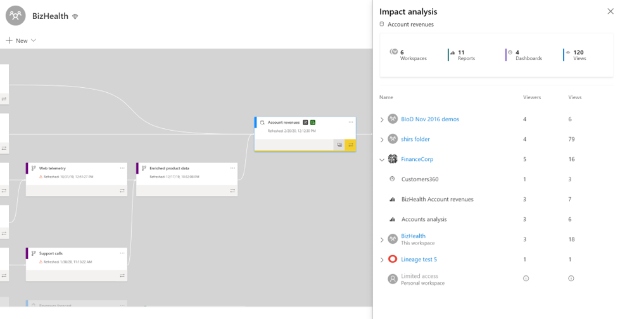Data lineage, impact, and API enhancements
Important
This content is archived and is not being updated. For the latest documentation, go to What's new in Power BI?. For the latest release plans, go to Dynamics 365 and Microsoft Power Platform release plans.
| Enabled for | Public preview | General availability |
|---|---|---|
| Admins, makers, marketers, or analysts, automatically |  Apr 30, 2021
Apr 30, 2021 |
- |
Business value
Further investments in capabilities and APIs make it easier for professionals and admins to manage their data assets and understand the relationships between artifacts. New improvements include admin scanner APIs and catalog integrations, lineage view support of composite models, and further lineage and impact enhancements.
Feature details
BI professionals use Power BI to build projects that span numerous artifacts: data sources, dataflows, datasets, reports, and dashboards. Providing insights about the data lineage in these projects is an important component for shaping efficient work processes. Data lineage insights empower users to better manage existing dependencies, troubleshoot issues in projects, derive the potential impact of planned changes, and increase confidence in important business KPIs. Data lineage insights also help BI professionals understand exactly where their data comes from and assess usage of various artifacts.
We've already introduced an experience for visualizing data lineage between different Power BI artifacts within a workspace. This experience includes APIs to extract lineage information and supports cross-workspace dependencies.
We've also added improvements to the data lineage view for better impact analysis, including:
- Providing impact analysis for datasets, both from the Power BI service and Power BI Desktop. This analysis can be used to evaluate the impact of planned changes and for troubleshooting.
- Providing impact analysis for connected data sources.
- Allowing users to act (such as to notify contacts) based on the predicted impact.
- Providing in-place usage information for both impact analysis and data lineage.
- Allowing admin APIs to efficiently scan Power BI artifact metadata and lineage and to return the list of workspaces that were changed since the last API call.
- Service principal authentication for Power BI read-only admin APIs that allow you to perform read operations using Power BI admin APIs without needing to sign in.

Moving forward, we’re investing further in capabilities and APIs, making it easier for professionals and admins to understand the relationships between artifacts and manage Power BI projects in their organization. Such capabilities include:
- Composite models in lineage view, allowing creators to view the connections and lineage of composite models and related artifacts.
- Admin APIs to efficiently scan Power BI artifact metadata and lineage. This new set of APIs will be used by administrators to view lineage information on all artifacts in Power BI. The administrator APIs support the use case of a large tenant with many artifacts and workspaces. With the metadata returned from the APIs, any customer or third-party tool can generate a catalog of Power BI artifacts with rich metadata and lineage cross tenant from the data-source to the dataflow and dataset then to the report and dashboard. Metadata returned will include properties that were not accessible with the existing APIs: description, sensitivity label-id, and endorsement label.
- An API that returns the list of workspaces that were changed since the last API call. With this API, customers can do incremental scans and save time and COGS for Premium workspaces.
- Service principal authentication for Power BI read-only APIs that allow administrators to perform read operations using Power BI admin APIs without needing to sign in. Service principal can replace master user and help customers build a more robust and secure solution when going to production.
See also
Enable service principal authentication for read-only admin APIs preview (docs)